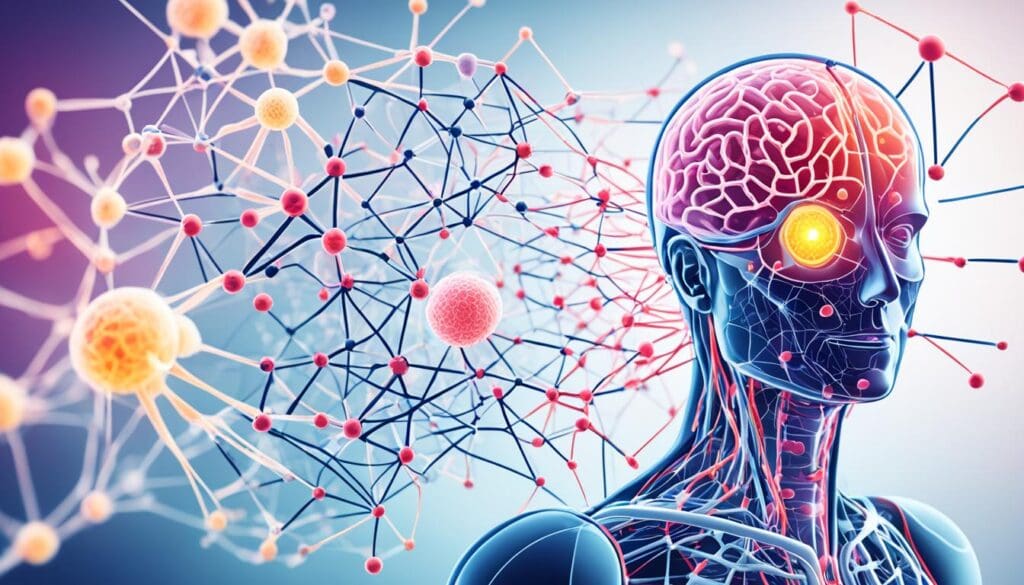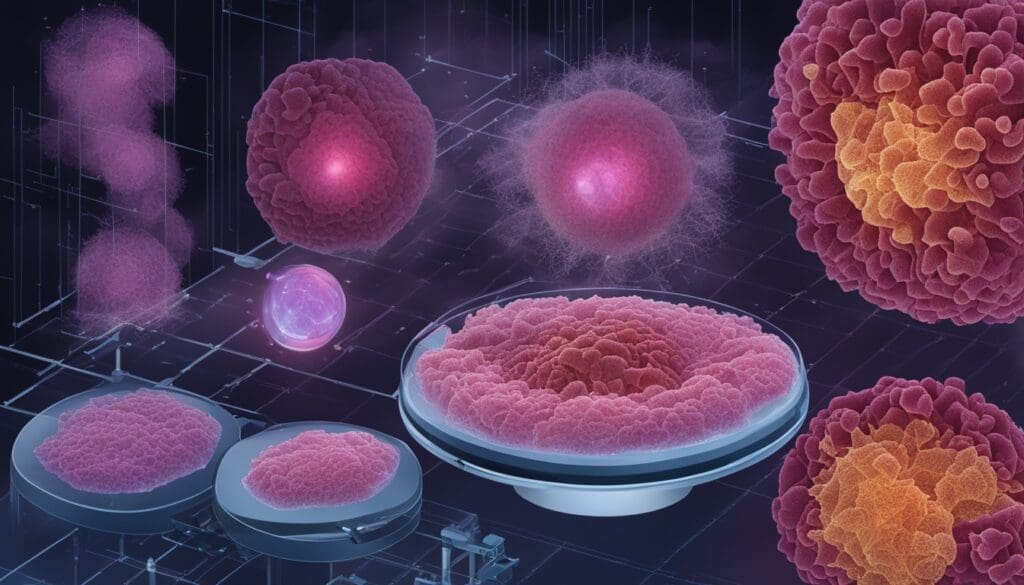Albert Einstein once said, “The significant problems we face cannot be solved at the same level of thinking we were at when we created them.” This quote is very true for cancer detection. We’ve faced big challenges that need new solutions. Luckily, AI and ML have changed cancer detection. They offer new tools and strategies for early diagnosis and tailored treatments.
Cancer is a big health issue, with over 19 million new cases and 10 million deaths in 2020. Finding cancer early is key to better patient outcomes and less disease burden. Machine learning and artificial intelligence have changed how we detect cancer. They help us see patterns and insights we couldn’t see before.

Key Takeaways
- AI and machine learning have changed cancer detection with new tools for early diagnosis and personalized treatment.
- Machine learning algorithms look at complex data and find patterns we might miss, making cancer diagnosis more accurate and efficient.
- Techniques like radiomics, deep learning, and ensemble methods are making cancer predictions more reliable and accurate, leading to better precision medicine.
- Researchers are finding new ways in machine learning, like transfer learning and unsupervised clustering, to improve cancer prediction.
- Using AI and machine learning in cancer detection could save lives by making early and accurate diagnoses, leading to better patient outcomes and less disease burden.
Introduction to Machine Learning in Cancer Detection
Machine learning (ML) and artificial intelligence (AI) are changing how we find and diagnose cancer. These technologies are making cancer screening, risk checks, and early treatment better. They use big data, smart algorithms, and predictive models to boost cancer detection accuracy and patient care.
Artificial Intelligence and Machine Learning: Definitions and Applications
AI means making machines think and act like humans. ML is a part of AI where machines learn from data to predict or classify things on their own. Together, AI and ML are changing medical fields like cancer detection and diagnosis. They can look through huge amounts of data, spot complex patterns, and make precise predictions. This leads to more tailored and effective cancer care.
The FDA has approved 521 AI-powered medical devices so far, showing how these technologies are becoming more common in healthcare. AI and ML are making early cancer screening and targeted treatments possible, changing how we fight this disease.
“Artificial intelligence and machine learning have the potential to transform cancer detection and diagnosis, leading to earlier intervention and improved patient outcomes.”
In cancer detection, AI algorithms are doing great things. They’re helping with lung cancer screening, prostate cancer diagnosis, and colorectal cancer prediction. These tools aim to make finding cancer more accurate and efficient, helping patients and their families live better lives.
Using machine learning and artificial intelligence is changing how we handle cancer. These technologies promise more personalized, data-based, and effective cancer care. They’re set to revolutionize oncology in the future.
Radiomics: The Foundation of AI in Cancer Imaging
Radiomics is changing how we spot and diagnose cancer. It uses computers to analyze medical images. Algorithms pull out important features from these images linked to disease traits or outcomes. This method, radiomics in cancer imaging, reveals insights beyond what we can see with our eyes.
Quantitative image analysis is key to using AI and ML in cancer imaging. It lets us find patterns and imaging biomarkers for cancer detection. These can help create machine learning models in radiology for predicting and diagnosing cancer.
This data-driven cancer imaging method could change how we fight cancer. By using radiomics, we can offer personalized care, early detection, and targeted treatments. This could lead to better patient outcomes and change healthcare for the better.
| Radiomics Applications in Cancer Imaging | Key Findings |
|---|---|
| Predicting treatment response to chemoradiotherapy in esophageal squamous cell carcinoma | Radiomic analysis using MRI can predict treatment response |
| Preoperative T category accuracy in locally advanced laryngeal carcinoma | A radiomic nomogram improves preoperative T category accuracy |
| Distinguishing tumor stage and pathological grade of bladder cancer | Radiomics analysis based on ultrasound images can distinguish tumor stage and grade |
| Differentiating benign and malignant liver tumors | Radiomics can differentiate between benign and malignant liver tumors using plain CT images and MRI |
These studies show how radiomics in cancer imaging can predict treatment outcomes, accurately stage cancers, and tell benign from malignant tumors. As we keep exploring this technology, we’re on the verge of even more breakthroughs in fighting cancer.
AI and ML Techniques in Cancer Imaging
The use of AI-powered image analysis and machine learning in medical imaging is complex. It includes steps like image preprocessing and transformation. These steps make sure the data is ready for ML algorithms and models.
Image Preprocessing and Transformation
Image preprocessing might include normalizing images, reducing noise, and aligning them. Transformation can turn 2D images into 3D or highlight important features. These steps are key for using AI in cancer detection and deep learning for tumor segmentation.
They make sure the results are reliable and accurate. By making the data consistent and highlighting important features, we can create strong AI and ML models. These models help improve cancer detection and diagnosis. They also help patients and support healthcare workers.

How Machine Learning is Revolutionizing Cancer Detection
The use of AI-assisted cancer screening and machine learning is changing how we find cancer early. These technologies offer new ways to spot cancer early and treat it better. This leads to better health outcomes for patients.
Deep learning in oncology imaging is a big step forward. AI can now beat human experts in finding lung cancer on X-rays and spotting cancer in tissue samples. Computer vision for tumor detection makes imaging quicker, more precise, and more detailed. This helps catch different cancers early.
Predictive analytics and neural networks for medical image analysis are leading to more tailored treatments. By looking at big health records, ML algorithms can spot people likely to get cancer. They look at symptoms, risk factors, and health stats.
| Key Advancements | Impact |
|---|---|
| Over 20 FDA-approved AI models for mammography screening | Enhancing breast cancer detection |
| Google’s DeepMind AI system for eye disease diagnosis | Surpassing human doctors in spotting over 50 eye diseases |
| PathAI’s AI in pathology to aid in disease diagnosis | Improving cancer diagnosis through advanced image analysis |
These new ways of looking at images and analyzing data are changing cancer detection. They offer chances for early diagnosis, tailored treatments, and better health outcomes for patients.
“AI has the potential to provide prognostic information for cancer treatment decisions with greater precision than humans.”
Large Database Analyses for Cancer Risk Identification
AI and machine learning are changing the game in cancer detection by analyzing big databases like electronic medical records. These advanced algorithms can go through these digital records fast. They use pattern recognition and natural language processing to spot people at high risk for different cancers.
This is super important for cancers like pancreatic cancer, which is rare. Screening everyone isn’t practical or affordable. By looking at health data, ML models can find those at higher risk. This makes targeted screening more effective.
AI’s power in risk assessment and predictive modeling is clear from recent breakthroughs. For example, AI beat radiologists in spotting lung cancer on chest X-rays. This shows how machine learning in population health and data-driven cancer screening are changing the game.
AI tools are also really good at diagnosing cancer and figuring out its severity, like the Gleason score for prostate cancer. Since only 5% of eligible patients get lung cancer screening, AI could help bridge this gap.
Using electronic health record analysis and big data in oncology is changing how we spot cancer risks. With AI and ML, doctors can make better decisions. This leads to better patient outcomes and a smarter use of resources in fighting cancer.
“AI applications in the medical sector have shown success in rapid and precise diagnosis, and cancer is still a leading cause of worldwide fatalities, emphasizing the need for error-free diagnosis.”
Image Analysis for Early Cancer Detection
Radiology is changing fast, thanks to AI and ML. These techs are changing how we look at cancer images. They can spot things in images with great accuracy and speed, often better than doctors. Humans can miss things due to tiredness, distractions, or missing important details. But AI doesn’t have these problems. It can find patterns and details in images that humans might miss.
Overcoming Human Limitations
Research shows AI can beat doctors at spotting lung cancer on X-rays. This shows AI could be a big help in finding cancer early. By using AI-powered cancer imaging, machine learning in radiology, and computer-aided detection in oncology, we can make cancer diagnosis more accurate and fast.
Also, combining deep learning for tumor segmentation and radiologist-algorithm collaboration could change how we find cancer. This mix of human skill and AI analysis could make our cancer detection better. It could also reduce the effects of overcoming human bias in medical imaging.

“AI-powered algorithms are not susceptible to the limitations of the human visual system and can detect subtle patterns and features in medical images that may be overlooked by human experts.”
Combining Data Analysis and Image Interpretation
The future of cancer detection is all about using AI to find cancer and multimodal machine learning models. By mixing big data and medical images, AI can look at a person’s cancer risk and suggest the best screening plans.
Deep learning algorithms are changing the game by spotting lung cancer risks. They look at medical records and chest X-rays together. This way, they can make predictive analytics for cancer screening that really work. It means more targeted care for those who need it most.
By blending data from medical records and images, doctors get a full picture of a patient’s cancer risk. AI helps doctors make better choices, creating plans that fit each patient’s needs.
| Technique | Application | Benefit |
|---|---|---|
| Convolutional Neural Networks (CNNs) | Medical imaging for early cancer detection | Automated, accurate, and fast identification of lesions or tumors in mammograms or lung scans |
| Natural Language Processing (NLP) | Integrating textual information with image data | Comprehensive patient understanding for more informed decision-making |
| AI-powered segmentation models | Outlining tumor boundaries | Precise measurement and tracking of tumor growth over time for improved treatment monitoring |
AI and machine learning are changing the way we fight cancer. By combining data analysis and image interpretation, doctors can spot cancer early and give patients better care.
Blood-based Multicancer Detection Tests
The future of cancer detection is in advanced, AI-powered liquid biopsy tests. These tests can check for many cancers with just one blood sample. They use machine learning in cancer biomarker discovery to look for biomarkers and genetic signs of cancer early.
The Galleri test is a great example. It can spot over 50 types of cancer. It uses multianalyte cancer screening and data-driven cancer diagnosis. The Galleri test finds abnormal DNA patterns linked to cancer through advanced DNA sequencing and AI-assisted cancer risk assessment.
- The Galleri test checks over 1 million DNA sites for cancer patterns.
- It uses machine learning to find a common cancer signal and guess the cancer type.
- It’s for adults over 50 with a high cancer risk, as they’re 13 times more likely to have cancer than younger people.
Blood-based multicancer detection tests could change how we screen for cancer. They offer a better and faster way than old methods. With AI and machine learning, these tests can find cancer early. This leads to better patient care and fewer deaths.
| Cancer Screening Method | Cost per Patient |
|---|---|
| Mammography | $1,800 – $2,500 |
| Colonoscopy | $2,500 – $5,500 |
| Lung Cancer Screening | $1,900 – $2,700 |
| Prostate Cancer Screening | $1,000 – $2,500 |
Earlier cancer diagnosis increases the chance of successful treatment and survival.
Blood-based multicancer detection tests are a big step forward in cancer care. They use AI and machine learning to change how we fight cancer. This leads to finding cancer sooner and better patient outcomes.
Conclusion
The use of artificial intelligence (AI) and machine learning has changed cancer detection a lot. These technologies bring new tools and strategies for early diagnosis and tailored treatments. They are changing how we fight cancer and care for patients.
Thanks to these new technologies, we can make cancer treatment better and lessen its impact. New research in radiology is showing how advanced tech like hyperspectral imaging and AI can improve medical image analysis. This could lead to new ways to diagnose and treat diseases.
We need to use AI and ML in cancer detection carefully and ethically. By working together and focusing on patients, we can make the most of these technologies. This will lead to better cancer care and a brighter future for fighting cancer.
FAQ
What is the role of artificial intelligence (AI) and machine learning (ML) in cancer detection?
AI and ML have changed how we find cancer. They look at lots of data, spot patterns, and make accurate predictions. This helps in early detection and tailored treatments.
How does radiomics contribute to the integration of AI and ML in cancer imaging?
Radiomics is about using computers to analyze medical images. It pulls out important details. These details help make predictions for cancer detection and diagnosis.
What are the key steps involved in the application of AI and ML techniques in cancer imaging?
To use AI and ML in cancer imaging, first, images are cleaned and made ready. This makes sure the data is right for the ML algorithms and models.
How can AI and ML help with the analysis of large databases for cancer risk identification?
ML algorithms look through electronic medical records to find people at high cancer risk. This helps focus screenings on those who need them most, especially for rare cancers.
What are the advantages of AI-powered image analysis compared to human experts in cancer detection?
AI algorithms beat human experts in some tasks like spotting lung cancer on X-rays and finding lymph node metastasis. They don’t get tired or distracted, and they don’t miss things humans might overlook.
How can the integration of data analysis and image interpretation enhance cancer detection?
Using both structured data from medical records and unstructured data from images, AI models get a full picture of a person’s cancer risk. This helps guide personalized screening plans.
What is the potential of blood-based multicancer detection tests in the field of cancer detection?
Blood tests that use AI and ML can find many types of cancer with one blood sample. This could change how we screen for and diagnose cancer.
Source Links
- https://www.ncbi.nlm.nih.gov/pmc/articles/PMC10178016/ – Computational Intelligence in Cancer Diagnostics: A Contemporary Review of Smart Phone Apps, Current Problems, and Future Research Potentials
- https://aggietranscript.ucdavis.edu/review-of-literature-use-of-deep-learning-for-cancer-detection-in-endoscopy-procedures/ – Review of Literature: Use of Deep Learning for Cancer Detection in Endoscopy Procedures
- https://www.mdpi.com/2072-6694/16/4/700 – Editorial: Recent Advances in Deep Learning and Medical Imaging for Cancer Treatment
- https://www.targetedonc.com/view/artificial-intelligence-and-machine-learning-in-cancer-detection – Artificial Intelligence and Machine Learning in Cancer Detection
- https://www.ncbi.nlm.nih.gov/pmc/articles/PMC10553229/ – The use of artificial intelligence tools in cancer detection compared to the traditional diagnostic imaging methods: An overview of the systematic reviews
- https://www.ncbi.nlm.nih.gov/pmc/articles/PMC10186733/ – Artificial intelligence-driven radiomics study in cancer: the role of feature engineering and modeling
- https://academic.oup.com/oncolo/article/27/6/e471/6555093 – Artificial Intelligence-based Radiomics in the Era of Immuno-oncology
- https://arxiv.org/pdf/2404.07239 – PDF
- https://www.bcrf.org/blog/ai-breast-cancer-detection-screening/ – AI Breast Cancer Detection and Diagnosis| Breast Cancer Research Foundation
- https://www.pharmacytimes.com/view/ai-is-revolutionizing-oncology-with-a-quantum-leap-in-cancer-treatment – AI Is Revolutionizing Oncology With a Quantum Leap in Cancer Treatment
- https://www.cancer.gov/news-events/cancer-currents-blog/2022/artificial-intelligence-cancer-imaging – Can Artificial Intelligence Help See Cancer in New Ways?
- https://www.ncbi.nlm.nih.gov/pmc/articles/PMC8946688/ – The Role of Artificial Intelligence in Early Cancer Diagnosis
- https://link.springer.com/article/10.1007/s10462-024-10783-6 – A comprehensive assessment of artificial intelligence applications for cancer diagnosis – Artificial Intelligence Review
- https://www.linkedin.com/pulse/revolutionizing-cancer-diagnosis-95-prediction-accuracy-toly-novik-ezdpc – Revolutionizing Cancer Diagnosis with 95% prediction accuracy: Harnessing the Power of Machine Learning and Image Analysis.
- https://www.sciencedirect.com/science/article/abs/pii/S0010482523008211 – Artificial intelligence in cancer diagnosis and therapy: Current status and future perspective
- https://www.nbcnews.com/health/health-news/promising-new-ai-can-detect-early-signs-lung-cancer-doctors-cant-see-rcna75982 – Promising new AI can detect early signs of lung cancer that doctors can’t see
- https://www.ncbi.nlm.nih.gov/pmc/articles/PMC10377683/ – Deep Learning for Medical Image-Based Cancer Diagnosis
- https://www.linkedin.com/pulse/revolutionizing-cancer-detection-power-ai-identifying-tissues-0sfbe – Revolutionizing Cancer Detection: The Power of AI in Identifying Cancer Tissues
- https://www.galleri.com/hcp/the-galleri-test-2 – MCED Test | Early Detection of Cancer with a Signal | Galleri® for…
- https://www.mdpi.com/2075-1729/14/7/833 – Technology and Future of Multi-Cancer Early Detection
- https://www.ncbi.nlm.nih.gov/pmc/articles/PMC10312208/ – Machine Learning and AI in Cancer Prognosis, Prediction, and Treatment Selection: A Critical Approach
- https://www.nature.com/articles/s43856-022-00199-0 – Artificial intelligence and machine learning in cancer imaging – Communications Medicine